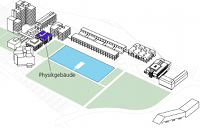To enable a better resolution during deep-tissue two-photon imaging and lithography, during my stay in the Bewersdorf Laboratory, a sensor-based AO system (a Shack-Hartmann wave front sensor and a deformable mirror), was incorporated into a custom-built two-photon STED microscope.
Position Indication:
Content

2017 - Julia Neuwirth
Two-Photon Excitation STED Microscopy
Research stay at the Bewersdorf Laboratory,
and Cell Biology Department, Yale, USA
May, 1st 2017 – Oct, 31st 2017
Julia Neuwirth
Contact: vorname.nachname1(/\t)gmail.com
As a Technical Physics master student at the JKU institute of Applied Physics under the direction of Prof. Thomas Klar I work on improving "STED-microscopy and -lithography using adaptive optics". Part of the research work of my thesis I conducted at the Department of Cell Biology in the Bewersdorf Laboratory at Yale university. There, they have expertise with respect to a novel microscopy technique called "Two-Photon Excitation STED Microscopy".
In the last quarter century, new fluorescence microscopy and lithography techniques have been developed to enable functional imaging of biological specimens and the writing of structures in the nanometer range. The performance of these methods, however, is often compromised by sample-induced optical aberrations. This leads to reduced imaging resolution in microscopy and inaccurate structures in lithography. Optical aberrations arise due to spatial variations in the refractive index of the specimen or photoresist — a problem that is exacerbated when imaging deep into biological tissue or structuring three-dimensional nanostructures.
In this project, we used adaptive optics (AO) to compensate for specimen-induced aberrations. Traditionally, AO has been used in astronomy to address the aberrating effects of atmospheric turbulence during telescope imaging. Similar, modified techniques can be implemented on microscope systems. Despite the different implementation, the essential components of any AO system are the same: an aberration measurement method (sensor- or metric-based), an adaptive element for aberration correction and a control system. The overall goal is that the correction element introduces an aberration equal in magnitude to that of the optical system, but with opposite sign. They then sum to zero, restoring (at least in principle) an un-aberrated operation.
Resolution in microscopy, long considered limited to 1/3 of the wavelength, can be overcome by switching off the fluorescence in the outer rim of the excitation beam quickly enough. One possibility to inhibit such a spontaneous emission is to use STED, STimulated Emission to Deplete the excited state.

Abb.1: STED
Common AO approaches describe aberrations using Zernike modes which had to be converted to a basis appropriate for our specific sensor. These conversions can cause additional inaccuracies. We addressed this challenge by developing a new set of aberration modes called “poke modes”. They represent a simplified control system based only on the underlying hardware, therefore eliminating the need for multiple conversions and in turn minimizing the amount of error introduced during analysis.
For this new control system, we demonstrate that test aberrations can be reliably compensated using the developed feedback control loop. In addition, aberrations induced by biological tissue (e.g. a 50 μm thick section of fixed mouse brain tissue) can be corrected, leading to an enhanced resolution and image quality.
During my research stay, I have developed and enriched my understanding of the concepts and techniques of super-resolution microscopy and lithography. In addition, I have been able to refine my English skills. The Bewersdorf Lab has granted me great opportunities for personal and professional development, the wonderful experience of working in a multicultural laboratory, where I made a lot of new friends from all over the world.
I am grateful to Dr. rer. nat. Joerg Bewersdorf and Prof. Dr. Thomas A. Klar for their mentorship during my stay and giving me the opportunity to perform my research abroad. In addition, many thanks go to the Wilhelm Macke Foundation to aid financial support for my research stay.


 Audit hochschule und familie
Audit hochschule und familie

